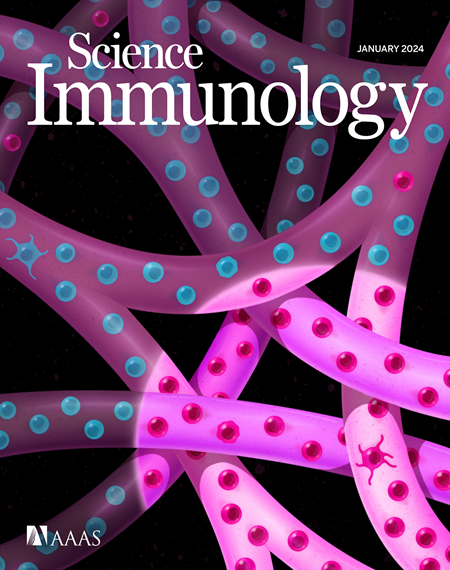Spatial transcriptomics stratifies psoriatic disease severity by emergent cellular ecosystems
IF 16.3
1区 医学
Q1 IMMUNOLOGY
引用次数: 2
Abstract
Whereas the cellular and molecular features of human inflammatory skin diseases are well characterized, their tissue context and systemic impact remain poorly understood. We thus profiled human psoriasis (PsO) as a prototypic immune-mediated condition with a high predilection for extracutaneous involvement. Spatial transcriptomics (ST) analyses of 25 healthy, active lesion, and clinically uninvolved skin biopsies and integration with public single-cell transcriptomics data revealed marked differences in immune microniches between healthy and inflamed skin. Tissue-scale cartography further identified core disease features across all active lesions, including the emergence of an inflamed suprabasal epidermal state and the presence of B lymphocytes in lesional skin. Both lesional and distal nonlesional samples were stratified by skin disease severity and not by the presence of systemic disease. This segregation was driven by macrophage-, fibroblast-, and lymphatic-enriched spatial regions with gene signatures associated with metabolic dysfunction. Together, these findings suggest that mild and severe forms of PsO have distinct molecular features and that severe PsO may profoundly alter the cellular and metabolic composition of distal unaffected skin sites. In addition, our study provides a valuable resource for the research community to study spatial gene organization of healthy and inflamed human skin.
空间转录组学通过新兴的细胞生态系统对银屑病的严重程度进行分层。
尽管人类炎症性皮肤病的细胞和分子特征已得到很好的表征,但其组织背景和系统影响仍知之甚少。因此,我们将人类银屑病(PsO)描述为一种典型的免疫介导的疾病,具有高度的皮肤外受累偏好。对25例健康、活动性病变和临床无关皮肤活检的空间转录组学(ST)分析以及与公共单细胞转录组学数据的整合显示,健康和发炎皮肤之间的免疫微区存在显著差异。组织规模制图进一步确定了所有活动性病变的核心疾病特征,包括发炎的基底上表皮状态的出现和病变皮肤中B淋巴细胞的存在。病变和远端非病变样本均根据皮肤病的严重程度而非系统性疾病的存在进行分层。这种分离是由巨噬细胞、成纤维细胞和淋巴富集的空间区域驱动的,这些区域具有与代谢功能障碍相关的基因特征。总之,这些发现表明,轻度和重度银屑病具有不同的分子特征,重度银屑病可能会深刻改变远端未受影响皮肤部位的细胞和代谢组成。此外,我们的研究为研究界研究健康和发炎人类皮肤的空间基因组织提供了宝贵的资源。
本文章由计算机程序翻译,如有差异,请以英文原文为准。
求助全文
约1分钟内获得全文
求助全文
来源期刊

Science Immunology
Immunology and Microbiology-Immunology
CiteScore
32.90
自引率
2.00%
发文量
183
期刊介绍:
Science Immunology is a peer-reviewed journal that publishes original research articles in the field of immunology. The journal encourages the submission of research findings from all areas of immunology, including studies on innate and adaptive immunity, immune cell development and differentiation, immunogenomics, systems immunology, structural immunology, antigen presentation, immunometabolism, and mucosal immunology. Additionally, the journal covers research on immune contributions to health and disease, such as host defense, inflammation, cancer immunology, autoimmunity, allergy, transplantation, and immunodeficiency. Science Immunology maintains the same high-quality standard as other journals in the Science family and aims to facilitate understanding of the immune system by showcasing innovative advances in immunology research from all organisms and model systems, including humans.
 求助内容:
求助内容: 应助结果提醒方式:
应助结果提醒方式:


